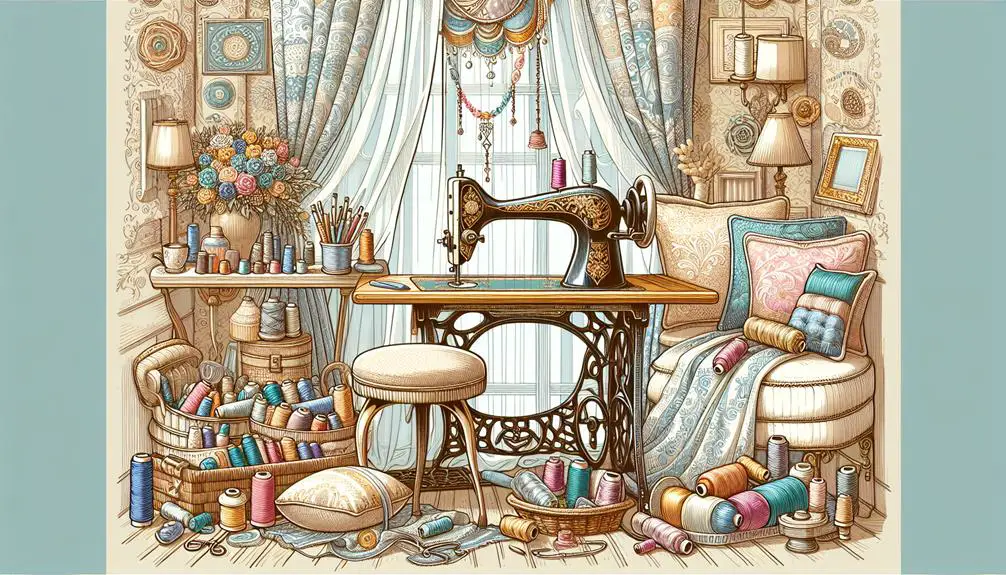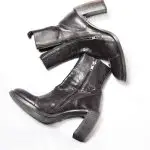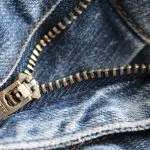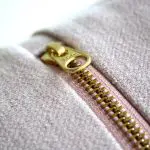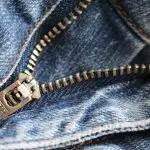When you master custom drapery techniques, craft elegant pillow covers, and create unique slipcovers, your home decor can truly stand out. Imagine transforming ordinary spaces with sophisticated seam finishes and intricate embroidery designs that showcase your attention to detail. Have you ever wondered how professional hemming advice or perfecting zipper installations can make a difference? By incorporating advanced sewing techniques, you can elevate the quality and aesthetic of your home decor, making each piece not only functional but also a tribute to your craftsmanship. So, what's the next step in honing these skills?
Table of Contents
Key Takeaways
- Utilize header tape or pleating tape for professional drapery finishes.
- Master invisible zipper installation for a clean look on pillows and slipcovers.
- Apply French seams for a polished and durable finish on lightweight fabrics.
- Experiment with quilting techniques like free-motion quilting for textured home decor.
- Incorporate advanced applique methods to create unique and intricate designs.
Custom Drapery Techniques
Creating custom drapery allows you to add a personalized touch to any room while mastering advanced sewing skills. You'll start by selecting the perfect fabric that complements your decor. Verify your fabric is of high quality, which will make a noticeable difference in both appearance and durability.
Next, focus on custom curtain rods and drapery hardware. These elements are essential for achieving a polished, professional look. Measure your windows precisely to determine the length and style of your custom curtain rods. Choose rods that not only fit your window dimensions but also enhance your chosen fabric. High-quality drapery hardware, such as brackets and finials, will provide the necessary support and add a touch of elegance.
When sewing the drapes, pay special attention to the hems and seams. Use advanced techniques like French seams or blind hems to create a clean, sophisticated finish. Don't forget to include a header tape or pleating tape to secure your drapes hang beautifully.
Elegant Pillow Covers
Transform your living spaces with elegant pillow covers that showcase your advanced sewing skills and personal style. Start by mastering fabric selection. Choose high-quality materials like silk, velvet, or linen to add texture and sophistication. Pay close attention to color coordination; select hues that harmonize with your existing decor to create a cohesive look.
Next, focus on pillow insert sizing. Measure your pillow inserts carefully to guarantee your covers fit snugly without excess fabric. A perfectly fitted cover enhances the overall elegance and provides better comfort. Consider various closure options for a professional finish. Invisible zippers offer a sleek, seamless look, while envelope closures provide ease of removal and washing.
Precision in your stitching is vital. Use a straight stitch for clean lines and reinforced seams to secure durability. Adding decorative elements like piping or embroidery can elevate your pillow covers to an artisanal level.
Crafting Unique Slipcovers
Crafting unique slipcovers allows you to refresh your furniture's appearance while showcasing your sewing skills. When approaching this project, consider slipcover alternatives to traditional patterns. For instance, you might opt for modular pieces that can be mixed and matched, providing both flexibility and a personalized touch.
Start by exploring various slipcover fabric choices. Opt for durable materials like heavy-duty cotton or canvas for a long-lasting finish, or choose luxurious fabrics like velvet for a more lavish look. When selecting your fabric, remember that the texture and weight will impact both the slipcover's appearance and its drape.
Next, immerse yourself in DIY slipcover ideas that can elevate your design. Custom fit slipcovers, for example, guarantee a snug and tailored look that standard options can't achieve. Additionally, consider incorporating slipcover embellishments such as piping, buttons, or decorative stitching to add unique details and professional polish.
Detailed Table Settings
When setting a table, you can impress your guests with elegant napkin folds, custom table runners, and handmade placemats.
These detailed touches not only showcase your sewing skills but also add a personal flair to any meal.
Let's explore how to create each of these elements to elevate your dining experience.
Elegant Napkin Folds
Elevate your dining experience by mastering a variety of elegant napkin folds that add a touch of sophistication to any table setting. Whether you're hosting holiday gatherings or intimate dinner parties, the art of napkin folding can transform your tablescape into a visual delight.
Here are three essential napkin folds to perfect:
- The Classic Fan Fold: This timeless fold is perfect for both casual and formal settings. Start by folding the napkin in half, then accordion-fold it from one end. Secure the base with a napkin ring and fan out the top for an eye-catching display.
- The Rose Fold: Ideal for romantic dinners or special occasions, this elegant napkin fold mimics the look of a blooming rose. Lay the napkin flat, fold it diagonally, and roll it tightly from the long end. Tuck the ends underneath and gently pull the layers to create petals.
- The Pocket Fold: Practical yet stylish, the pocket fold is great for holding cutlery or menu cards. Fold the napkin into quarters, then fold the top layer down diagonally. Turn it over and fold the sides inward to form a neat pocket.
Custom Table Runners
Creating custom table runners allows you to personalize your table settings and add a unique touch to your dining decor. By carefully selecting fabrics and employing advanced sewing techniques, you can elevate your table to a whole new level of sophistication. Start by choosing a fabric that complements your existing decor and custom tablecloths. Consider luxurious materials such as linen, silk, or velvet for an elegant finish.
To truly make your table runner stand out, incorporate monogrammed linens. Personalization techniques, such as embroidery or appliqué, can add a distinctive touch that reflects your style. Monogramming can be done using a sewing machine with an embroidery function or by hand for a more artisanal look.
Here's a quick guide to help you plan your custom table runner:
| Step | Description | Tips |
|---|---|---|
| 1. Measure | Determine the length and width needed | Add extra for seams and hems |
| 2. Fabric Selection | Choose fabric | Match or contrast with custom tablecloths |
| 3. Cut Fabric | Cut to the desired dimensions | Use sharp scissors for clean edges |
| 4. Hem Edges | Sew a hem around all sides | Press with an iron for neatness |
| 5. Personalize | Add monograms or decorative elements | Experiment with different techniques |
Handmade Placemats
Handmade placemats not only complement your custom table runners but also enhance the overall aesthetic of your dining experience. They provide an opportunity to showcase your sewing skills while adding a personal touch to your table settings.
To achieve mastery in creating handmade placemats, focus on these three essential elements:
- Fabric Selection and Color Coordination: Choose fabrics that not only match your table runners but also harmonize with your dining room's overall color scheme. Opt for high-quality materials like linen or cotton for a polished look. Think about how different patterns and textures will interact to create a cohesive and inviting atmosphere.
- Hand Stitched Embellishments: Elevate your placemats with intricate hand stitched embellishments. Techniques such as embroidery, appliqué, or even simple hand quilting can add a unique flair and depth. These details not only personalize your placemats but also highlight your craftsmanship.
- Personalization Techniques: Make your placemats truly one-of-a-kind by incorporating monograms, custom motifs, or seasonal themes. Consider using contrasting thread colors or metallic threads to make your designs pop. Personalization transforms ordinary placemats into bespoke pieces that reflect your artistic vision.
Mastering Seam Finishes
Mastering seam finishes guarantees your garments look professional and last longer. Whether you're working with delicate fabrics or heavy materials, using the right technique can make all the difference. Let's delve into some essential seam finishes that will elevate your sewing skills.
French seams offer a clean, professional look, encasing raw edges within the seam. They're perfect for lightweight fabrics and sheer materials. On the other hand, serger techniques provide a quick, durable finish, ideal for knit fabrics and high-stress seams. A serger can trim and finish edges simultaneously, speeding up your process.
Bias binding is another versatile method, ideal for finishing necklines, armholes, and seams. It involves encasing the raw edge with a strip of fabric cut on the bias, allowing for flexibility and a clean finish. Overcasting methods, whether done by hand or machine, prevent fraying and offer a neat, sturdy edge for various fabric types.
Here's a quick reference table for these techniques:
| Technique | Best For | Benefits |
|---|---|---|
| French Seam | Lightweight fabrics | Clean, enclosed edges |
| Serger Techniques | Knit fabrics | Fast, durable finish |
| Bias Binding | Necklines, armholes | Flexible, neat finish |
| Overcasting | Various fabrics | Prevents fraying, sturdy |
Advanced Applique Methods
When exploring advanced applique methods, you'll want to focus on:
- Layering fabric for added depth.
- Using precision cutting techniques.
- Experimenting with creative stitching patterns.
These methods will elevate your projects and give them a unique, professional touch.
Ready to transform your applique skills?
Layering Fabric for Depth
Layering fabric in applique techniques adds depth and dimension to your sewing projects, making them visually striking and unique. By mastering fabric manipulation and employing advanced layering techniques, you can create pieces that truly stand out.
Here's how you can achieve remarkable results:
- Fabric Manipulation and Layering Techniques:
Start by selecting fabrics with varying textures and weights. Experiment with different combinations to find what works best for your design. Layering fabrics strategically creates a sense of depth through fabric, transforming a flat design into a multi-dimensional masterpiece.
- Depth through Fabric and Texture Combinations:
To enhance the visual appeal, mix fabrics like silk, cotton, and velvet. The contrast between smooth and rough, light and heavy fabrics will add a tactile quality to your applique. Play with color contrasts and fabric patterns to further enrich the depth and intrigue of your project.
- Securing Layers for Stability:
Use a temporary adhesive spray or fusible webbing to hold your layers in place before stitching. This guarantees that your pieces remain stable as you sew, allowing you to focus on perfecting your technique without worrying about shifting fabrics.
Precision Cutting Techniques
Achieving precision in cutting fabric is important for creating intricate and professional-looking applique designs. Start by investing in high-quality cutting tools. Rotary cutters and specialized applique scissors offer the control needed for detailed work. Always make sure your blades are sharp to prevent frayed edges and guarantee clean cuts.
Mastering fabric marking techniques is vital. Use fabric-specific marking pens or chalk to outline your designs precisely. This step is essential for fabric pattern matching, ensuring your applique pieces align perfectly with the underlying fabric. Remember, accurate marking sets the foundation for flawless cutting and sewing.
To maintain consistency, use templates or stencils. These guides help you replicate intricate shapes repeatedly without deviation. When cutting, take your time and follow the marked lines meticulously. Rushing through this process can lead to uneven edges and misaligned patterns.
Lastly, don't overlook sewing machine maintenance. A well-maintained machine ensures smooth stitching, preventing fabric from shifting during the applique process. Regularly clean your machine and check for any issues to keep it in top condition.
Creative Stitching Patterns
Now that you've mastered precision cutting techniques, let's explore creative stitching patterns to elevate your applique projects. Advanced applique methods can transform your home decor by adding depth and artistic flair. By mastering fabric manipulation and creative embellishments, you'll bring a unique touch to each piece.
Here are three advanced stitching techniques to get you started:
- Satin Stitch: This dense, smooth stitch is perfect for outlining shapes or adding bold, solid lines. Adjust the width and length for various pattern variations and effects. It's ideal for creating clean, professional edges on your applique.
- Couching: This technique involves laying a thicker thread or yarn on your fabric and securing it with small, nearly invisible stitches. It allows for intricate designs and adds texture and dimension to your project. Experiment with different materials for creative embellishments.
- Buttonhole Stitch: Also known as the blanket stitch, this versatile method is excellent for securing applique edges while adding a decorative touch. Vary the spacing and size of the stitches to create different visual effects and pattern variations.
Intricate Embroidery Designs
Mastering intricate embroidery designs can elevate your sewing projects to a new level of artistry and craftsmanship. Start by selecting colorful thread choices that complement your fabric. The right hues can transform basic patterns into stunning works of art.
Focus on intricate needlework, perfecting techniques like satin stitch, French knots, and chain stitches to add depth and texture to your designs.
Personalized monogramming offers a sophisticated touch to home decor items like towels, pillows, and table linens. Use delicate embellishments such as beads, sequins, or metallic threads to make each monogram unique. This not only showcases your skill but also adds a luxurious feel to everyday items.
To achieve precision, always use stabilizers to keep your fabric taut and prevent puckering. Invest in high-quality embroidery hoops and needles, as they make a significant difference in the outcome of your work. Practice on scrap fabric before committing to your final piece, ensuring your design is flawless.
Professional Hemming Tips
Often underestimated yet essential for a polished finish, professional hemming techniques can greatly enhance the appearance and durability of your garments. Mastering these methods will set your work apart, giving it a refined and long-lasting quality.
To achieve such professional finishes, consider the following expert tips and hemming hacks:
- Utilize a Blind Hem Stitch: This technique provides an invisible hem, ideal for dress pants, skirts, and home decor items like curtains. By utilizing a blind hem foot on your sewing machine, you'll achieve a clean look without visible stitching.
- Double-Fold Hem: For a sturdy edge, especially on thicker fabrics, fold the hem twice before stitching. This method not only conceals raw edges but also adds weight, guaranteeing the hem lays flat. It's a reliable shortcut for achieving a neat, professional finish quickly.
- Press Before Sewing: Always press your hem before you sew. This step guarantees crisp folds and reduces the risk of puckering. A well-pressed hem looks more professional and is easier to sew accurately.
Perfecting Zipper Installations
Achieving a polished garment doesn't stop at hemming; perfecting zipper installations is equally important for a professional finish. By mastering both invisible and metal zippers, you'll elevate your sewing projects to a couture level.
Start with the invisible zipper, a favorite among high-end designers. This zipper is hidden within the seam, giving your garment a sleek, uninterrupted look. To achieve this, use an invisible zipper foot and baste the seam where the zipper will go. Guarantee the teeth of the zipper face the fabric's right side and stitch close to the teeth for that flawless finish.
Next, let's talk about metal zippers, essential for functional finishes in items like jeans or jackets. They're durable and add a touch of industrial chic to your creations.
When installing a metal zipper, use a standard zipper foot and reinforce the fabric edges with interfacing to prevent wear and tear. Topstitching around the zipper isn't just functional—it adds a decorative element that highlights your sewing skills.
Creating Fabric Textures
To create enchanting fabric textures, you can explore techniques like pleating and ruching, which add volume and interest.
Smocking allows you to craft unique patterns that stand out, while quilting can give your projects added depth and warmth.
Let's take a closer look at how each method can transform your sewing projects.
Pleating and Ruching Methods
Mastering pleating and ruching techniques can transform ordinary fabric into eye-catching textures that elevate your sewing projects. By honing your skills in fabric manipulation, you'll be able to craft designs that are both sophisticated and unique.
Let's delve into the world of gathering techniques, exploring the various ruching variations and pleat styles that can add depth and character to your home decor.
Here are three key techniques to master:
- Knife Pleats: This classic pleat style involves folding fabric in one direction, creating sharp, uniform lines. It's perfect for adding a structured look to drapes or cushion covers.
- Box Pleats: By folding fabric in alternating directions, you can create a series of rectangular shapes. Box pleats offer a more voluminous and tailored appearance, ideal for bed skirts or tablecloths.
- Shirring: This gathering technique involves sewing parallel rows of stitches and then pulling the threads to create small, even gathers. Shirring is a versatile method that works well for adding texture to curtains or pillow shams.
Smocking for Unique Patterns
Building on the fabric manipulation skills you've acquired, smocking introduces a mesmerizing way to create intricate patterns and textures that set your projects apart. By gathering fabric in precise ways, you can form unique patterns that add depth and dimension to your home decor projects. Smocking techniques are not just about decoration; they're about transforming a flat piece of fabric into a three-dimensional work of art.
To master smocking, understanding the different styles is essential. Here's a quick guide:
| Smocking Technique | Description |
|---|---|
| English Smocking | Uses dots to create uniform pleats, ideal for consistent patterns. |
| Canadian Smocking | Involves manipulating fabric on the grid, making it perfect for complex textures. |
| Honeycomb Smocking | Creates a raised, honeycomb-like texture, great for pillows and cushions. |
| Lattice Smocking | Produces a crisscross pattern, adding a geometric touch to your projects. |
These advanced embroidery techniques allow you to create intricate designs that are both visually appealing and structurally fascinating. When you employ these smocking techniques, you're not just sewing; you're crafting unique patterns that elevate your home decor to a whole new level.
Quilting for Added Depth
Delving into quilting, you'll discover how layering fabrics and stitching them together can create rich textures and add depth to your projects. By mastering modern techniques, you'll elevate your home decor to new levels of sophistication. With quilting inspiration from various sources, you can experiment with diverse approaches to achieve unique outcomes.
To get started, consider these three key aspects:
- Layering Fabric: Begin by selecting multiple fabric types and colors. Layering different materials not only adds visual interest but also enhances the tactile experience. Think about using cotton, linen, and even velvet for a luxurious feel.
- Creative Patterns: Develop intricate designs by playing with geometric shapes, floral motifs, or abstract forms. Creative patterns can transform a simple quilt into a statement piece that complements your decor. Use templates or freehand your designs for a personalized touch.
- Modern Techniques: Embrace advanced methods such as free-motion quilting, trapunto, or sashiko. These techniques allow for greater creativity and precision, giving your projects a professional finish. Modern techniques also offer innovative ways to incorporate texture and depth, making your work stand out.
Frequently Asked Questions
What Types of Fabrics Are Best for Home Decor Projects?
Think of fabric selection like choosing ingredients for a gourmet meal. You'll want color coordination, pattern matching, and texture contrast. For home decor projects, opt for durable fabrics like cotton, linen, and velvet for the best results.
How Can I Maintain and Clean My Sewn Home Decor Items?
To maintain and clean your sewn items, focus on fabric care and stain removal by following the manufacturer's instructions. Use proper storage solutions to prevent odors and preserve quality. Regularly inspect for stains and address them promptly.
What Basic Sewing Tools Are Essential for Home Decor Projects?
You'll need a quality sewing machine, sharp fabric scissors, measuring tape, pins, and needles. Prioritize sewing machine maintenance and sewing room organization to guarantee efficiency and keep your tools in top condition for advanced projects.
How Do I Choose the Right Thread for Different Fabrics?
Choosing the correct thread can be tricky. Prioritize thread weight and fabric compatibility. Guarantee color coordination enhances your project. For perfect thread selection, match thread type to fabric and keep your colors harmonious.
Are There Any Specific Sewing Machine Settings for Heavy Upholstery Materials?
For heavy upholstery materials, adjust your sewing machine tension and use a larger needle size for heavy materials. Increase stitch length and adjust presser foot pressure for upholstery fabric to guarantee smooth, professional results.
- How Does Ring Spun Cotton Affect Garment Fit and Shape Retention? - August 13, 2024
- What Are the Challenges in Producing Ring Spun Cotton? - August 13, 2024
- Is Ring Spun Cotton Suitable for Plus-Size Clothing? - August 13, 2024

